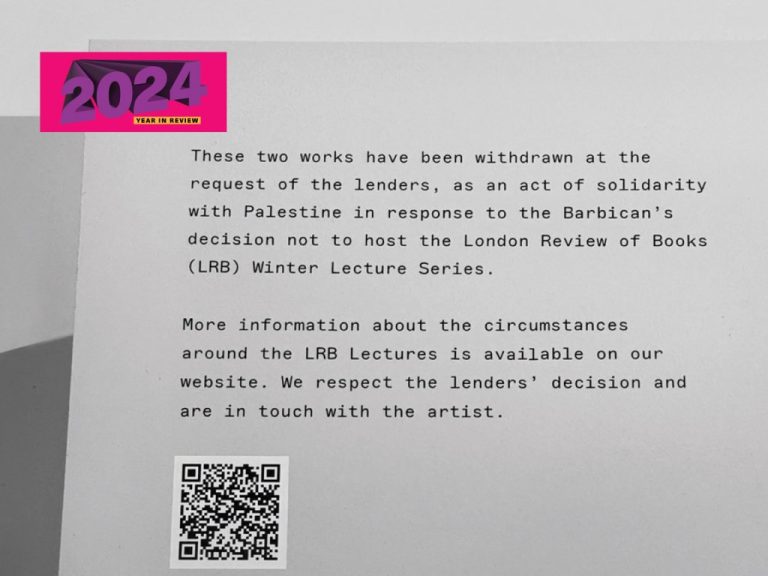Before 2024 even begins, and arguably even before October 7, 2023, the art world is divided between Israel and Palestine. But this year, the divide widened further until there was no room for nuanced debate. Suspicions of anti-Semitism and anti-Palestinian sentiment are spreading in every corner, and looking to museums for guidance is sure to disappoint some. From New York’s Noguchi Museum to Switzerland’s Kunstmuseum Bern to Qatar’s Mataf, cultural institutions around the world have been accused of censoring artists and curators in 2024, in many cases based on their pro-Palestinian politics .
The number of accusations has risen so sharply in the United States that in March this year, the New York-based National Alliance Against Censorship launched the Arts Censorship Index, an online tool that tracks the state of free speech across the country.
Censorship seems to be black and white: a piece of art is either altered or removed for political reasons, and the thinking is that if politics aren’t an issue, then the work won’t be censored. But the reality is more complicated, as accusations of censorship can be tricky from a legal perspective and rulings often depend on the changing cultural climate. The Index defines censorship as an event in which an institution “explicitly cancels, withdraws or abandons a project or work after it has been communicated, and the reason for the withdrawal is related to the work’s political content, personal interests”. The artist’s politics, or national or cultural associations relevant to the content of the work. ” The key word here is “perception.”
In one of the most high-profile incidents of the year, a group of artists pulled their artwork from a textiles exhibition at London’s Barbican Centre. The demolition was a protest against the Barbican no longer hosting events. london review of books Lecture on the historical links between the Holocaust and the Israeli attack on Gaza.
According to the Barbican, the decision to withdraw from the talks came after LRB The “premature” announcement of the event and its title meant Barbican management did not have time to “make the careful preparation required for this sensitive content”. in a statement The Art NewspaperYto Barrada, one of the artists taking part in the protest, said the decision showed “the gradual normalization of censorship in art institutions”.
Artist and activist Nan Goldin, an outspoken critic of Israel’s war in Gaza, has made one of the year’s most public accusations of censorship in Germany, which is at the center of several pieces of legislation surrounding criticism of Israeli art. at the center of the controversy. In December, Goldin claimed that Berlin’s Neues Nationalgalerie initially refused to allow her to add a statement about Israeli killings of people in Gaza, Lebanon and the West Bank to sexual dependence balladher groundbreaking 1985 photo slideshow, appeared in a survey hosted by the agency.
Goldin said the statement originally read: “Solidarity with the people of Gaza, the West Bank and Lebanon. And the Israeli civilians who were killed on October 7.” Goldin called it censorship; the museum disagreed and Responding in German media, the problem was that Goldin’s original statement was not approved because it did not mention the Israeli victims of October 7. Museum director Klaus Biesenbach said in an interview with journalist Hanno Hauenstein: “The museum stands by the fact that artists have freedom of expression as long as they abide by our code of conduct. rights.” The slide was eventually updated to include a reference to Israel and displayed publicly.
This year’s growing censorship controversies have ultimately and inevitably created a crisis of confidence in institutions that purportedly exist as historical repositories. If museums can’t be trusted to tell our stories, who can? These concerns even extend beyond the Palestinian issue. Taking November as an example, wall street journal An investigation revealed that Biden-appointed Archivist of the United States Colleen Shogan directed the National Archives to modify photographic exhibits focusing on American civil rights. One of the most controversial orders was the removal of a portrait of Martin Luther King Jr. and Dorothea Lange’s photograph of a Japanese-American incarceration camp, which was deemed “too negative.”
in a statement wall street journalA spokesman for Shogan’s department said the changes were made to make the show more relatable to regular visitors. Ai Weiwei – whose gallery Lisson postponed an exhibition after he tweeted critical of Israel – has also made headlines for saying censorship in the West is “sometimes even worse than in Mao Zedong’s China”. He told the outlet that this was partly due to a crackdown on pro-Palestinian speech on U.S. college campuses. The Art Newspaper “In the context of Western censorship, there is a pervasive illusion that the West embodies greater freedom of speech and press, portraying itself as a society with the least censorship. However, I believe that as long as there is power, censorship will continue to exist.”


